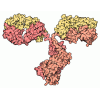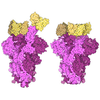[English] 日本語
 Yorodumi
Yorodumi- PDB-9kux: Cryo-EM structure of dimeric APJR and one Beta-arrestin complex w... -
+ Open data
Open data
- Basic information
Basic information
| Entry | Database: PDB / ID: 9kux | ||||||
|---|---|---|---|---|---|---|---|
| Title | Cryo-EM structure of dimeric APJR and one Beta-arrestin complex with small molecules | ||||||
 Components Components |
| ||||||
 Keywords Keywords | SIGNALING PROTEIN / APJR / Beta-arrestin / GPCR | ||||||
| Function / homology | :  Function and homology information Function and homology information | ||||||
| Biological species |  Homo sapiens (human) Homo sapiens (human) | ||||||
| Method | ELECTRON MICROSCOPY / single particle reconstruction / cryo EM / Resolution: 3.57 Å | ||||||
 Authors Authors | Yue, Y. / Wu, L.J. / Xu, F. | ||||||
| Funding support | 1items
| ||||||
 Citation Citation |  Journal: Nat Commun / Year: 2025 Journal: Nat Commun / Year: 2025Title: Mechanistic insights into the versatile stoichiometry and biased signaling of the apelin receptor-arrestin complex. Authors: Yang Yue / Chanjuan Xu / Lijie Wu / Man Na / Kexin Xu / Xuan Chen / Yuxuan Song / Sichun Weng / Lu Xu / Fei Li / Xi Lin / Arthur Wang / Jianfeng Liu / Fei Xu /  Abstract: The apelin receptor (APJR) plays a pivotal role in regulating cardiovascular and metabolic health. Understanding the mechanisms of biased agonism at APJR is crucial for drug discovery, as stimulation ...The apelin receptor (APJR) plays a pivotal role in regulating cardiovascular and metabolic health. Understanding the mechanisms of biased agonism at APJR is crucial for drug discovery, as stimulation of the β-arrestin pathway may lead to some adverse effects. Structural analyses of APJR-Gi complexes have clarified the structural basis of receptor dimerization and activation, yet the absence of structural data on APJR-arrestin complexes has impeded a comprehensive understanding of APJR stoichiometry in the dual signaling pathways and biased agonism. Here, we present APJR-β-arrestin1 structures bound to a clinical drug analog, revealing 2:2 and 2:1 stoichiometries associated with differential β-arrestin recruitment. Through comparison of the two transducer-coupled APJR structures bound to the same ligand, we identify key residues and motifs crucial for directing biased signaling. These findings highlight APJR's versatile stoichiometry in coupling with β-arrestin and Gi proteins, establishing a framework for understanding biased agonism and guiding the development of therapeutics. | ||||||
| History |
|
- Structure visualization
Structure visualization
| Structure viewer | Molecule:  Molmil Molmil Jmol/JSmol Jmol/JSmol |
|---|
- Downloads & links
Downloads & links
- Download
Download
| PDBx/mmCIF format |  9kux.cif.gz 9kux.cif.gz | 223.5 KB | Display |  PDBx/mmCIF format PDBx/mmCIF format |
|---|---|---|---|---|
| PDB format |  pdb9kux.ent.gz pdb9kux.ent.gz | Display |  PDB format PDB format | |
| PDBx/mmJSON format |  9kux.json.gz 9kux.json.gz | Tree view |  PDBx/mmJSON format PDBx/mmJSON format | |
| Others |  Other downloads Other downloads |
-Validation report
| Arichive directory |  https://data.pdbj.org/pub/pdb/validation_reports/ku/9kux https://data.pdbj.org/pub/pdb/validation_reports/ku/9kux ftp://data.pdbj.org/pub/pdb/validation_reports/ku/9kux ftp://data.pdbj.org/pub/pdb/validation_reports/ku/9kux | HTTPS FTP |
|---|
-Related structure data
| Related structure data |  62583MC  9kuvC  9kuwC M: map data used to model this data C: citing same article ( |
|---|---|
| Similar structure data | Similarity search - Function & homology  F&H Search F&H Search |
- Links
Links
- Assembly
Assembly
| Deposited unit | 
|
|---|---|
| 1 |
|
- Components
Components
| #1: Antibody | Mass: 68345.000 Da / Num. of mol.: 1 Source method: isolated from a genetically manipulated source Source: (gene. exp.)  Homo sapiens (human) / Production host: Homo sapiens (human) / Production host:  Trichoplusia ni (cabbage looper) Trichoplusia ni (cabbage looper) | ||||||
|---|---|---|---|---|---|---|---|
| #2: Protein | Mass: 57685.527 Da / Num. of mol.: 2 Source method: isolated from a genetically manipulated source Source: (gene. exp.)  Homo sapiens (human) / Production host: Homo sapiens (human) / Production host:  Trichoplusia ni (cabbage looper) Trichoplusia ni (cabbage looper)#3: Chemical | Mass: 525.580 Da / Num. of mol.: 2 / Source method: obtained synthetically / Formula: C24H27N7O5S Has ligand of interest | Y | Has protein modification | Y | |
-Experimental details
-Experiment
| Experiment | Method: ELECTRON MICROSCOPY |
|---|---|
| EM experiment | Aggregation state: PARTICLE / 3D reconstruction method: single particle reconstruction |
- Sample preparation
Sample preparation
| Component | Name: beta_apj / Type: COMPLEX / Entity ID: #1-#2 / Source: RECOMBINANT |
|---|---|
| Source (natural) | Organism:  Homo sapiens (human) Homo sapiens (human) |
| Source (recombinant) | Organism:  Trichoplusia ni (cabbage looper) Trichoplusia ni (cabbage looper) |
| Buffer solution | pH: 7.4 |
| Specimen | Embedding applied: NO / Shadowing applied: NO / Staining applied: NO / Vitrification applied: YES |
| Vitrification | Cryogen name: ETHANE |
- Electron microscopy imaging
Electron microscopy imaging
| Experimental equipment |  Model: Talos Arctica / Image courtesy: FEI Company |
|---|---|
| Microscopy | Model: FEI TALOS ARCTICA |
| Electron gun | Electron source:  FIELD EMISSION GUN / Accelerating voltage: 300 kV / Illumination mode: FLOOD BEAM FIELD EMISSION GUN / Accelerating voltage: 300 kV / Illumination mode: FLOOD BEAM |
| Electron lens | Mode: BRIGHT FIELD / Nominal defocus max: 2200 nm / Nominal defocus min: 700 nm |
| Image recording | Electron dose: 60 e/Å2 / Film or detector model: GATAN K3 BIOQUANTUM (6k x 4k) |
- Processing
Processing
| EM software |
| ||||||||||||||||||||||||
|---|---|---|---|---|---|---|---|---|---|---|---|---|---|---|---|---|---|---|---|---|---|---|---|---|---|
| CTF correction | Type: PHASE FLIPPING ONLY | ||||||||||||||||||||||||
| 3D reconstruction | Resolution: 3.57 Å / Resolution method: FSC 0.143 CUT-OFF / Num. of particles: 213186 / Symmetry type: POINT | ||||||||||||||||||||||||
| Refinement | Highest resolution: 3.57 Å Stereochemistry target values: REAL-SPACE (WEIGHTED MAP SUM AT ATOM CENTERS) | ||||||||||||||||||||||||
| Refine LS restraints |
|
 Movie
Movie Controller
Controller




 PDBj
PDBj

